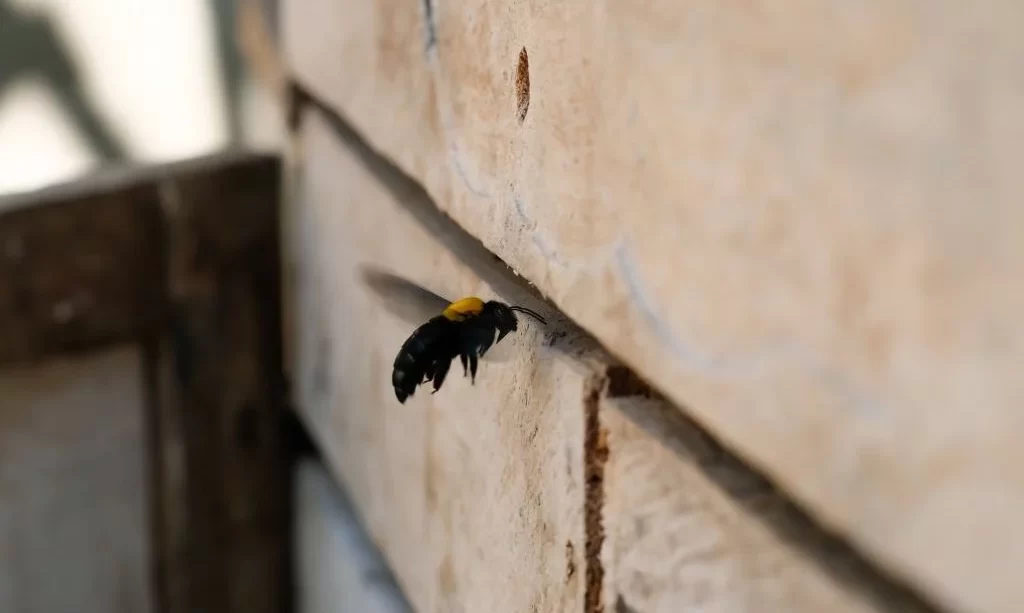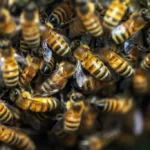Carpenter bees, often regarded as the architects of the insect world, play a unique role in nature with their nesting habits. These remarkable creatures are known for their ability to drill perfectly round holes into wooden structures, creating nests that can be found in various outdoor locations. But just how many carpenter bees are typically found in a nest? To uncover the answer to this question, we’ll delve into the intriguing world of carpenter bee nesting behavior. Understanding their solitary nature and nesting habits is essential for anyone looking to coexist with or manage these industrious insects.
Carpenter Bee Nesting Behavior
Carpenter bees, belonging to the Xylocopa genus, exhibit fascinating nesting behavior that sets them apart from other bee species. Here’s an overview of their nesting behavior:
- Wooden Nesting Sites: Carpenter bees are named for their affinity for wood. They create nests by drilling circular entrance holes into various wooden structures, including eaves, decks, fences, and even tree branches.
- Solitary Nesters: Unlike social bees like honey bees, carpenter bees are solitary insects. Each female carpenter bee constructs and maintains her own nest independently. This solitary nature distinguishes them from hive-dwelling bees.
- Egg-Laying and Provisioning: The female carpenter bee is responsible for the entire nesting process. She bores into the wood to create a gallery, where she lays her eggs in separate cells. After laying an egg in a cell, she provisions it with a mixture of pollen and nectar. This stored food will sustain the developing larva when it hatches.
- Multiple Cells: A single carpenter bee nest may consist of several cells, each housing an egg and its provisions. The female typically works her way deeper into the gallery, creating new cells as she goes. This results in a linear arrangement of cells within the nest.
- Overwintering: Carpenter bees exhibit seasonal behavior. In colder climates, the adults may die off during the winter months, but their offspring (larvae) remain protected within the nest until spring. They emerge as adults when the weather warms.
Understanding the nesting behavior of carpenter bees sets the stage for exploring how many carpenter bees are typically found in a nest. It’s essential to remember that carpenter bees are solitary insects, and each nest is typically the work of a single female bee. In the sections that follow, we’ll delve deeper into the number of carpenter bees per nest and explore their unique nesting sites.
Solo Nests: The Norm
Carpenter bees are renowned for their solitary nesting behavior, and this characteristic sets them apart from many other bee species. Here’s why solo nests are the norm for carpenter bees:
- Independent Nesting: Unlike social bees, such as honey bees and bumblebees, carpenter bees do not live in colonies or hives. Instead, each female carpenter bee is an independent nest builder. She selects a suitable nesting site and constructs her nest entirely on her own.
- Minimal Cooperation: Carpenter bees do not engage in cooperative behaviors like hive construction, foraging, or rearing of offspring collectively. Each female carpenter bee is responsible for all aspects of her nest, from drilling the entrance hole to laying eggs and providing food for her larvae.
- Territorial Nesting: Carpenter bees are known to be territorial. They often return to the same nesting sites year after year, especially if those sites offer suitable conditions. This territorial behavior reinforces the solitary nature of their nests.
- Limited Social Interaction: While males and females may interact briefly for mating purposes, their interactions are limited in scope and do not involve cooperative nesting activities. Males may be seen hovering near nest entrances but do not play a significant role in nest construction or care.
Understanding that carpenter bees are solitary nesters is crucial when considering how many carpenter bees are typically found in a nest. Each nest is primarily the work of a single female carpenter bee, which is a distinctive aspect of their nesting behavior.
Female Carpenter Bee Activities
The female carpenter bee takes on a pivotal role in the nesting process. Here’s a closer look at her activities within the nest:
- Nest Construction: The female carpenter bee begins by drilling a perfectly round entrance hole into a wooden structure. This hole serves as the gateway to her nesting gallery, which she creates inside the wood. The gallery may extend several inches into the wood.
- Egg Laying: Once the gallery is established, the female carpenter bee lays her eggs in separate cells within the gallery. She usually places a single egg in each cell, ensuring that each larva will have access to sufficient provisions for its development.
- Provisioning the Cells: Before sealing each cell, the female carpenter bee collects pollen and nectar, forming a provision mass. This stored food will serve as sustenance for the developing larva when it hatches from the egg. The provisions also contain essential nutrients and proteins.
- Sealing the Cells: After placing an egg and its provisions in a cell, the female seals the cell with wood particles, creating a barrier that protects the developing larva. She repeats this process for each cell within her nesting gallery.
- Sequential Cell Arrangement: As the female carpenter bee progresses deeper into the gallery, she creates new cells, each following the same pattern of egg laying, provisioning, and sealing. This results in a linear arrangement of cells within the nest, with the oldest cells located closer to the entrance.
Understanding the activities of the female carpenter bee sheds light on how she manages her nest and ensures the survival of her offspring. Each nest created by a female carpenter bee is a remarkable feat of solitary craftsmanship, and the number of carpenter bees typically found in a nest depends on her reproductive activity.
Number of Carpenter Bees per Nest
The number of carpenter bees typically found in a nest can vary depending on the reproductive activity of the female carpenter bee. Here’s an explanation of the factors influencing the number of carpenter bees in a nest:
- Single Female Per Nest: In a typical carpenter bee nest, there is usually one female carpenter bee in residence. Each female carpenter bee is responsible for constructing and maintaining her own nest independently. This solitary nature is a fundamental characteristic of carpenter bee nesting behavior.
- One Egg per Cell: Within her nest, the female carpenter bee may create multiple cells, each housing a single egg. The number of cells depends on factors such as the availability of suitable wood and environmental conditions. Each cell contains one egg and a provision mass of pollen and nectar.
- Varied Nest Size: The size of a carpenter bee nest can vary from a few cells to several, depending on the reproductive activity of the female. Some nests may consist of only a couple of cells, while others may have more, especially if the female is particularly active in laying eggs.
- Sequential Nesting: Female carpenter bees often build additional nests in close proximity to their previous nests. This sequential nesting behavior can result in several nests near one another, with each nest housing a single female and her offspring.
It’s important to note that while individual nests are typically solitary and contain one female carpenter bee, multiple nests may be found in close proximity to each other, especially in areas with suitable nesting sites. This can create the appearance of higher bee activity in a localized area.
Nesting Site Variability
The number of carpenter bee nests in a specific area can vary due to several factors related to nesting site availability and environmental conditions. Here’s an exploration of nesting site variability:
- Wood Availability: Carpenter bees require access to suitable wooden structures for nesting. The availability of suitable nesting sites can significantly influence the number of carpenter bee nests in an area. Abundant wooden structures, such as eaves, fences, or wooden furniture, can attract more carpenter bees.
- Environmental Factors: Environmental conditions, such as temperature and humidity, can also play a role in nesting site selection. Carpenter bees may prefer nesting sites that provide shelter from extreme weather conditions.
- Territorial Behavior: Carpenter bees exhibit territorial behavior, with females often returning to the same nesting sites year after year if conditions remain suitable. This can lead to the persistence of carpenter bee nests in specific locations.
- Competition: In areas with limited suitable nesting sites, competition among female carpenter bees for nesting locations may occur. This competition can result in more nests clustered together in proximity.
Understanding the variability in nesting site availability and the factors influencing carpenter bee nest distribution can provide insights into the number of nests that may be found in a particular area.
In the following sections, we’ll explore methods for identifying carpenter bee nests and discuss how to manage carpenter bee nests if they become a concern.
Identifying Carpenter Bee Nests
Identifying carpenter bee nests is essential for understanding their presence and managing potential concerns. Here’s how to recognize carpenter bee nests:
- Circular Entrance Holes: One of the most distinctive signs of a carpenter bee nest is the perfectly round entrance hole in wood. These holes are typically about the diameter of a pencil and are smooth and uniform in appearance.
- Wood Shavings and Sawdust: Around the entrance hole, you may find a pile of fine wood shavings and sawdust. Carpenter bees excavate tunnels within the wood, and this debris is a result of their drilling activity.
- Hovering Behavior: Female carpenter bees may be observed hovering near the entrance holes, especially during the nesting season. This behavior is often an indicator of nest location.
- Visible Tunnels: In some cases, you may be able to see the tunnels or galleries created by carpenter bees if the wood is soft or if the entrance hole has been exposed.
- Presence of Carpenter Bees: If you observe carpenter bees entering and exiting a hole, it’s a strong indication of an active nest. Be cautious when approaching, as female carpenter bees may become defensive if they perceive a threat.
Dealing with Carpenter Bee Nests
While carpenter bees are essential pollinators and play a valuable role in ecosystems, their nesting habits can sometimes lead to concerns, especially if they choose nesting sites near human structures. Here are some strategies for dealing with carpenter bee nests:
- Observation and Tolerance: If carpenter bees are not causing damage or posing a threat, consider simply observing and tolerating their presence. They are valuable pollinators and play a role in ecological balance.
- Preventive Measures: To deter carpenter bees from nesting in wooden structures, consider applying paint or wood sealants to the surfaces. Carpenter bees prefer untreated wood for nesting.
- Blocking Entrance Holes: If you discover an inactive carpenter bee nest, you can plug the entrance hole with wood putty or a wooden dowel to prevent future use. Ensure the nest is inactive before sealing it.
- Professional Assistance: If carpenter bee activity becomes problematic or poses structural concerns, consider seeking assistance from pest control professionals who can assess the situation and provide appropriate solutions.
Conclusion
Understanding the nesting habits of carpenter bees and the number of bees typically found in a nest is essential for coexisting with these valuable pollinators. Carpenter bees are solitary nesters, and each nest is primarily the work of a single female bee. While they may create multiple cells within a nest, each cell typically contains one egg and provisions for one larva.
Identifying carpenter bee nests involves recognizing the distinctive circular entrance holes and associated wood shavings. However, it’s essential to consider the ecological importance of carpenter bees and, when possible, coexist with them peacefully.
If carpenter bee activity becomes a concern due to nesting near human structures, preventive measures and professional assistance can help manage the situation effectively. By striking a balance between conservation and property protection, we can appreciate the remarkable carpenter bees while addressing potential challenges they may pose.




